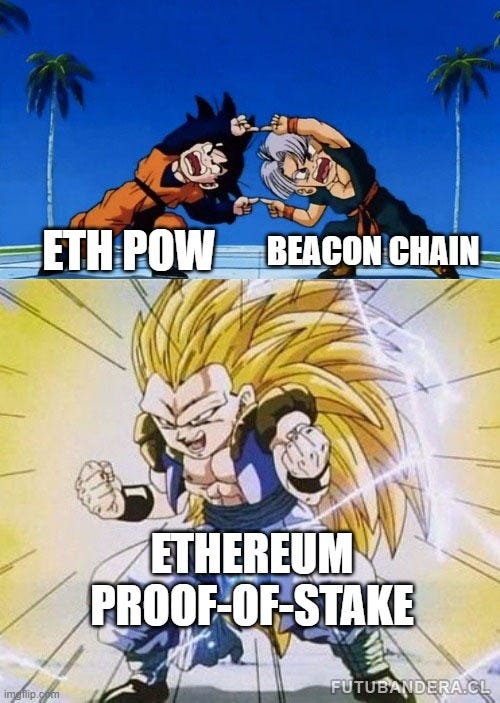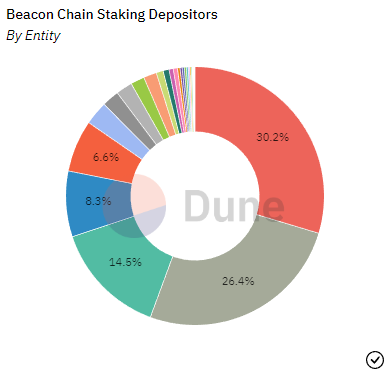Disclaimer, NFA, all that legal stuff: All the information presented on this publication and its affiliates is strictly for educational purposes only. It should not be construed or taken as financial, legal, investment, or any other form of advice.
Hi folks 🙋🏻♂️,
I want to take a moment and thank the early supporters of this newsletter. I’ve been writing it for the past two months and it is growing steadily. On average, each issue gets around 500 views with the very first issue hitting 2,000 views. While this number might look small for some of you (still larger than the typical 101 lecture halls in Universities), it’s a great start and I can’t wait to look back at it in the next few months.
The Ethereum merge is ongoing as I’m writing this issue. Frankly, I wasn’t really sure what to write about this week. This monumental event took the limelight and it wouldn’t make much sense to write about anything else. That said, the merge has been covered by everybody and their moms; so I don’t plan to bother my early supporters with another long piece about why the merge is good or bad for Ethereum.
Instead, this issue will be presented in a quick bite format with relevant sources, and topped off with a sprinkle of my personal takes.
Bon Appétit!
The Merge
At this point, we’re all aware that the merge is the act of merging the existing Ethereum network with a Proof-of-Work (PoW) consensus with an existing parallel chain that has been running with a Proof-of-Stake (PoS) consensus called the Beacon Chain. It will transition the Ethereum network from PoW to PoS.
Why it matters: Ethereum is the most utilized blockchain with more than $30 billion of value built across decentralized applications built on top of it. ETH is also the second largest crypto asset with close to $200 billion in market capitalization.
The merge will also prove that it is possible to maintain and upgrade a massive decentralized network, further proving that the vision of web 3.0 is feasible.
What’s happening: The merge is years in the making and the crypto community is excited (and anxious) to see the outcome of the merge. There are many benefits of the merge for the Ethereum network, but the primary ones are:
Reduce the Ethereum network’s energy consumption by 99%.
Ethereum is currently consuming as much electricity as the Netherlands.
Like it or not, the investment space is increasingly trending towards the ESG narrative. This criticism is a common talking point against BTC and the broader crypto market in general.
If we want crypto to get more institutional adoptions, we need Ethereum to be energy-friendly.
Reduce new ETH supply issuance rate by ~90%.
Currently, 14,600 new ETH are being issued every day. After the merge, this number would go down to just 1,600.
The annual inflation rate will go down from 4.62% to 0.49%.
Including the burn after the EIP-1559 upgrade, ETH will most likely become a deflationary asset.
Prepare the Ethereum network for further scaling upgrades.
There are further upgrades to the Ethereum network that will address scalability and transaction fees. Moving the network to a Proof-of-Stake one is the first step to achieving more.
Sharding, a technique that splits the network into smaller partitions, essentially spreading the load horizontally and helping scale the network, will be able to be implemented after the merge.
Vitalik has provided the community with a roadmap that can be summarized as:
The Surge: sharding and TPS scaling
The Verge: Verkle Trees intro and validator decentralization
The Purge: cut down space and simplifying the protocol
The Splurge: smaller upgrades to maintain the network
What to expect:
ETH holders and Ethereum network users don’t need to do anything. While the merge is a technical feat, it will happen in the background and will be unnoticeable for the majority of retail users.
Gas fees and transaction speed will remain the same. A bummer, I know — but the merge is not intended to address these issues. Instead, the next upgrade after the merge, called Shanghai, will be addressing both of these issues.
Staked ETH and the subsequent rewards can’t be withdrawn. The newly issued ETH will be locked for at least 6-12 months, and can only be withdrawn after the Shanghai upgrade.
ETH PoW fork date has been announced. Unsurprisingly, the existing miners don’t want to waste their hardware and have chosen the option to fork the Ethereum network to “Ethereum PoW”. If this actually happens, $ETHW will be “airdropped” to ETH holders on the new Ethereum PoW chain.
Power concentration amongst the top validators. One of the most valid criticisms against the PoS model is that there’s a likelihood for power to be concentrated amongst the top staking pools. The top 5 pools currently own 75%+ of the funds securing the Ethereum network.
My Takes
As presented above, there are numerous factors that go into the merge, and there are different actors with varied incentives. Post merge, we’ll need to assess:
How will the Ethereum PoW fork play out?
How will the MEV landscape change?
Will there be an increasing trend towards staking pool centralization?
Will the Shanghai upgrade be delayed? How will this impact withdrawals?
Will ETH yield truly become the “risk-free rate” of crypto?
I usually see values in making predictions but not so much for the current situation. The bottom line is that the merge is a net positive move for the Ethereum network, given the reduction in energy cost as well as the issuance rate. Further upgrades and post-merge maintenance will be required to ensure the network’s robustness in a new PoS environment as well as to address its existing scalability and gas fee issues.
I think ETH price will still be primarily impacted by the macro markets and will still be seen as a risk-on asset, but it will start to de-correlate a lot more with BTC. Institutional allocators can no longer use the ESG talking points to not invest in ETH and it will now start producing yield that can be considered DeFi protocols’ risk-free rate.
All in all, the merge will show that the crypto community can achieve difficult technical feats in a decentralized manner, further proving that a much more open and equitable future of the web that we’re all working towards is indeed achievable.
A Moment of Reflection
Queen Elizabeth died. Whether you like the Monarchy or not, it couldn’t be denied that they have a large impact on the world, for better or for worse. The reality is that most of us won’t have the same amount of impact when we’re done with our lives. To me, this means that there are more reasons for us to pause, take a breather, and look at our current situation in life compared to one year ago. For those of you trying this, hopefully, the outcome shines a positive light on how much things have changed. We’re often caught up in this crazy fast-paced crypto world, thinking that it’s too late to “make it”. Yield farming ponzinomics are saturated, dog coins are no longer giving 50x returns, and bad VC funds continuously dump on retail. In retrospect, all of that might not matter because your life can change a lot in one year. Take stock of your blessings, pause, and prioritize the most important things — if that’s work, that’s perfectly fine, but I find that we often forget about the other things.
Until next time,
Marco M.
If you enjoy this piece, you can support my work by taking a moment to share it with others who might also find it useful — cheers.










